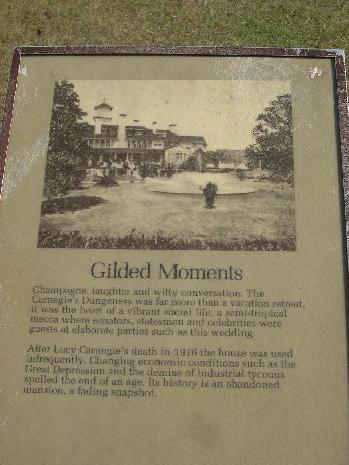 |
 |
 |
 |
 |
 |
 |
 |
 |
 |
 |
 |
 |
 |
 |
 |
 |
 |
 |
 |
 |
 |
 |
 |
 |
 |
 |
 |
 |
 |
 |
|
|
|
|
|
|
|
|
|
|
|
|
|
|
|
|
|
|
|
|
|
|
|
|
|
|
|
|
|
|
|
|

|
|
|
|
|
|
|
|
|
|
|
|
|
|
|
|
|
HISTORICAL CUMBERLAND ISLAND
|
|
|
|
|
|
|
|
|
|
|
|
|
|
|
|
|
|
|
Two families a hundred years apart built houses on the island with the same name, Dungeness. The name was originally the name of a county seat in England. Then General Oglethorpe used the name for a hunting camp here, and the name was later adopted by Nathaneal Green for the first house near this site. Finally, Thomas and Lucy Carnegie named their Dungeness in the late 1880's. Thomas died before the house was completed but his wife, Lucy Coleman Carnegie, finished it and brought her nine children here. Eventually she owned 90% of the island. She oversaw the construction of four additional homes on the island for her children. Two of the homes, Greyfield Inn and Plum Orchard, still survive. With the Depression and the enactment of income tax laws, Cumberland Island was less and less used. By 1959 when it burned, Dungeness had been vacant for years.
|
|
|
|
|
|
|
|
|
 |
|
 |
|
|
|
|
|
|
|
|
|
Pictures of pictures of Dungeness in its heyday.
|
|
|
|
|
|
|
|
|
 |
|
 |
|
|
|
|
|
|
|
|
|
Picture of the fire in 1959 which destroyed Dungeness
|
|
|
|
|
|
|
|
|
|
Approaching the ruins of Dungeness today
|
|
|
|
|
|
|
|
 |
|
 |
|
|
|
|
|
|
|
|
|
Views of the front ruins of Dungeness.
|
|
|
|
|
|
|
|
|
 |
|
 |
|
|
|
|
|
|
|
|
|
|
View of the back ruins of Dungeness with
plaque (right ) in the foreground.
|
|
|
|
|
|
|
|
|
|
|
|
|
|
|
|
|
|
Plaque behind Dungeness:
Gilded Moments
"Champagne, laughter and witty conversation. The Carnegie's Dungeness was far more than a vacation retreat, it was the heart of a vibrant social life, a semi-tropical mecca where senators, statesmen and celebrities were guests at elaborate parties such as this wedding.
After Lucy Carnegie's death in 1916 the house was used infrequently. Changing economic conditions such as the Great Depression and the demise of industrial tycoons spelled the end of an age. Its history is an abandoned mansion, a fading snapshot."
|
|
|
|
|
|
|
|
|
|
 |
|
|
|
|
|
|
|
|
Plum Orchard, one of the homes Lucy Carnegie built for her children, is managed and being renovated by the Park Service. Tours of the mansion are conducted only once a month so we did not get to visit it although we caught a glimpse as we headed up the ICW. It is a good distance north of Dungeness.
|
|
|
|
|
|
|
|
|
|
|
|
 |
|
|
|
|
|
|
 |
|
|
|
|
|
|
|
|
|
|
|
Transportation around the large island was first by horse-drawn rail carriage then by power-driven electrics.
|
|
|
|
|
|
|
|
|
|
|
|
|
|
|
|
|
Indoor swimming pool of the Recreation Building where only ruins remain of the wood-shingled building. Originally, the building had guest rooms, squash court, gym, and billiard room. There were also a beauty parlor and barber shop here.
|
|
|
|
|
|
|
|
|
|
|
|
|
|










